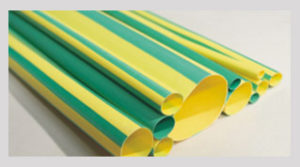
Heat shrink products like ‘heat shrink tubes’ are an indispensable accessory in most of the industrial applications. It is a versatile item that helps to protect, electrically insulate and bundle cables as well as act as an environmental seal preventing contaminants in any form from affecting sensitive components. The process of making this accessory is an interesting one and the following brief makes it clear.
How the Extruded Tubing is made Heat Shrinkable?
Making polyolefin or PVC tubing heat shrinkable is done after the process of initial extrusion is completed. Force is used under the setting of high temperatures for expanding the tubing’s diameter. The tubing remains partially stable at this new size but shrinks back to its original extruded dimension on application of heat from a heat gun. Heat application can also be done by use of an oven or any other thermal energy source. However, in this process a large part is played by the shrink ratio of the tubing. The shrink ratio varies from 2:1, 2.5:1, 3:1, 4:1 or so and determines to what extent the tubing will shrink on application of heat. For example, a shrink ratio of 3:1 indicates that the tubing will shrink to 1/3rd of its initial diameter. Some manufacturers offer customized shrink ratios to suit specific requirements of clients. Sometimes, some heat shrink tubes have an adhesive coating on the insides which also melt when heat is applied and this enables it to fit snugly over the electrical component acting as a water-tight seal. In addition to the shrinkage in diameter, longitudinal shrinkage also occurs. But this is quite insignificant as compared to the circular shrinkage.
Usage of Varied Materials
Polyolefin and PVC are commonly used materials for the making of this tubing. The factors that determine their usage are the cost and the temperature levels that have to be withstood in the application. For example, an automobile’s interiors and instrument panels will use PVC tubing whereas the engine area will require the usage of polyolefin tubing. The broader range of operating temperature is given to the polyolefin tubing by the thermoset material that goes into its making. PVC tubing on the other hand is made from thermoplastic material.
Electrical & Other Applications
Heat shrink tubes are used in a number of applications but most commonly in wiring harnesses. It is used for bundling loose cables or providing strain relief. They protect the cables from abrasion, chipping, cutting, peeling or denting besides cushioning them from any impact. They come in vibrant hues and therefore they are used in applications which require ‘glow-in-the-dark’ or neon colours or those who are concerned about the aesthetic appearance of their cables. Color coding becomes possible by use of these tubes and sometimes they prove useful in giving data regarding the model number, company logo, name or contact numbers, manufacture date, instructions for use and safety warnings.
All cable accessories like this heat shrink tubes and others such as 36KV cable joints, transition joints, heat shrink boots etc are a boon to the industrial sector.